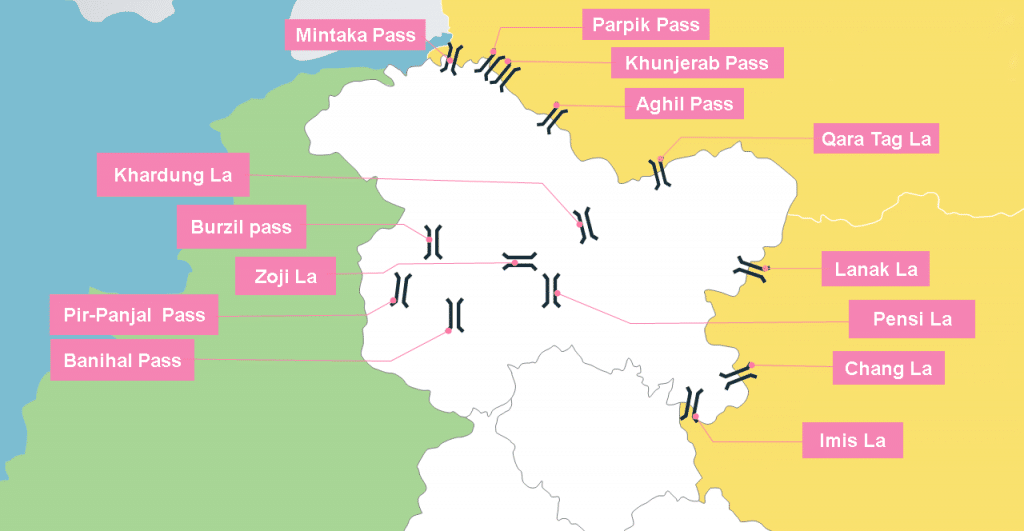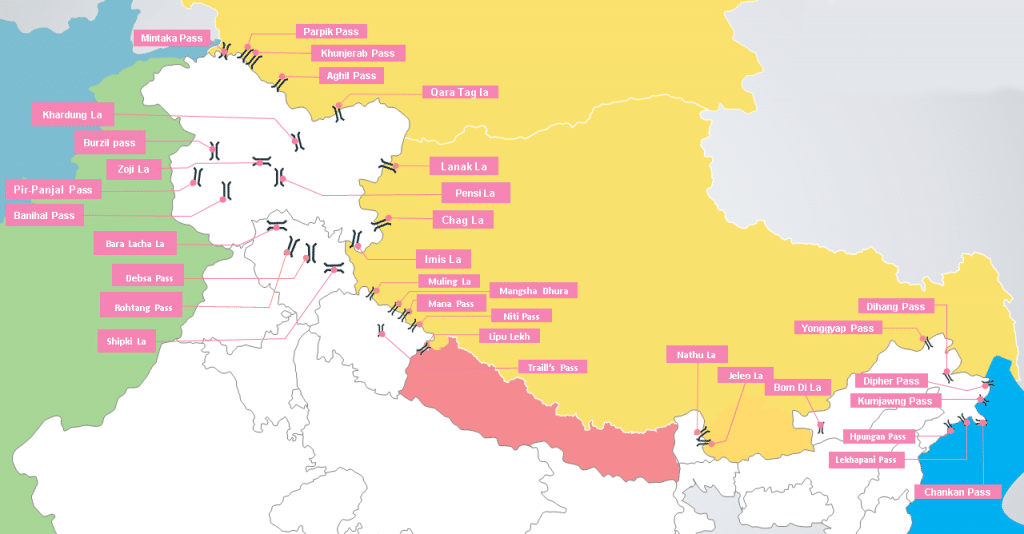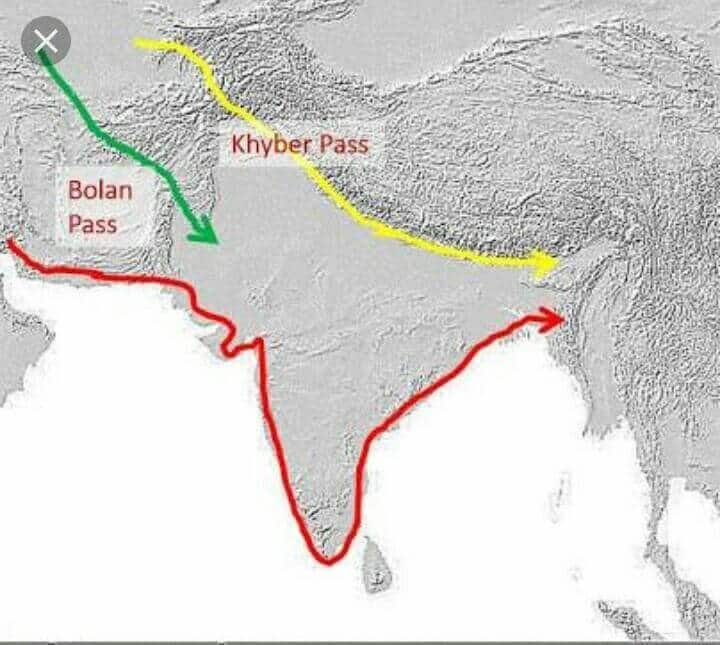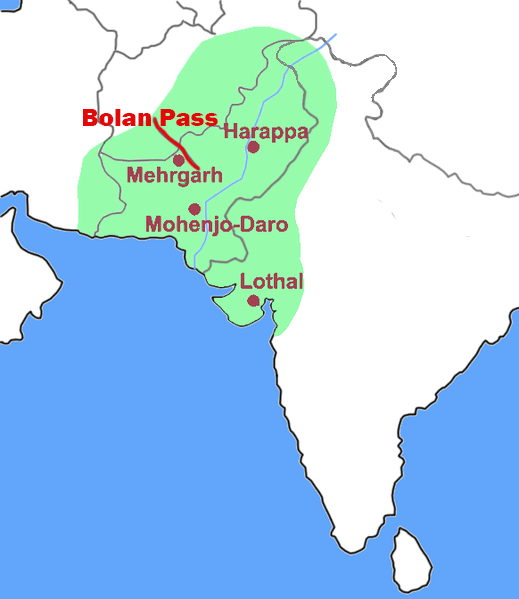In this article, You will read the Important Mountain Passes in India and Indian Sub-continent for UPSC IAS.
Mountain Passes in India
Mountain pass is a connectivity route through the mountain run. It is a gateway to connect different parts of the country and also with neighboring countries for different purposes.
Mountain pass is a navigable route through a mountain range or over a ridge. Passes have played a key role in trade, war, and both human and animal migration throughout history.
At lower elevations it may be called a hill pass.
Mountain Passes are often found just above the source of a river, constituting a drainage divide. A pass may be very short, consisting of steep slopes to the top of the pass, or maybe a valley many kilometers long, whose highest point might only be identifiable by surveying.
Important Mountain Passes in India
Zoji La (Pass)-It is in the Zaskar range of Jammu & Kashmir. The road route from Srinagar to Leh goes through this pass. It has been created by the Indus River.
Banihal Pass-Banihal Pass is a mountain pass across the Pir Panjal Range at a maximum elevation of 2,832 m. It connects the Kashmir Valley in the union territory of Jammu and Kashmir to the outer Himalayas and the plains to the south. In the Kashmiri language, “Banihāl” means blizzard.
Shipki La (Pass)-Shipki La is a mountain pass and border post with a dozen buildings of significant size on the India-China border. The river Sutlej enters India near this pass.
Bara-Lacha Pass- Bara-lacha la also known as Bara-lacha Pass, is a high mountain pass in the Zanskar range, connecting Lahaul district in Himachal Pradesh to Leh district in Ladakh, situated along the Leh–Manali Highway.
Rohtang Pass-It is a high mountain pass on the eastern end of the Pir Panjal Range of the Himalayas around 51 km from Manali. It connects the Kullu Valley with the Lahaul and Spiti Valleys of Himachal Pradesh, India.

Mana Pass-The pass is one of the highest vehicle-accessible passes in the world, containing a road constructed in the 2005-2010 period for the Indian military by the Border Roads Organisation. Mana Pass is the last point between India and China’s Border.
Niti Pass-The Niti Pass located at 5800 meters connects India with Tibet. The pass is located in Uttarakhand.
Nathu La (Pass)-Nathu La is a mountain pass in the Himalayas in the East Sikkim district. It connects the Indian state of Sikkim with China’s Tibet Autonomous Region. Nathu means “listening ears” and La means “pass” in Tibetan.
Jalep La (Pass)-Jelep La or Jelep Pass, elevation 4,267 m or 13,999 ft, is a high mountain pass between East Sikkim District, Sikkim, India, and Tibet Autonomous Region, China. It is on a route that connects Lhasa to India.
Mountain Passes in India (state wise) – Location & Significance
Mountain Passes in Leh & Ladakh

| Khardung La | It is the highest motorable pass in the country. It connects Leh and Siachen glaciers. This pass remains closed during the winter. |
| Thang La / Taglang La | It is located in Ladakh. It is the second-highest motorable mountain pass in India. |
| Aghil Pass | It is situated to the North of Mount Godwin-Austen in the Karakoram. It connects Ladakh with the Xinjiang province of China. It remains closed during the winter season from November to May. |
| Chang-La | It is a high mountain pass in the Greater Himalayas. It connects Ladakh with Tibet. |
| Lanak La | This is located in the Aksai Chin in the Ladakh region. It connects Ladakh and Lhasa. The Chinese authority has built a road to join Xinjiang with Tibet. |
| Imis La | The pass has a difficult geographical terrain and steep slopes. This pass remains closed during the winter season. It connects Ladakh and Tibet. |
| Bara-La/ Bara- Lacha La | It is situated on the National Highway in the state of Jammu and Kashmir. It connects Manali and Leh. |
Mountain Passes in Uttarakhand

| Traill’s Pass | It is located in Uttarakhand. It is situated at the end of the Pindari glacier and connects the Pindari valley to Milam valley. This pass is very steep and rugged. |
| Lipu Lekh: Uttarakhand-Tibet | It is located in Uttarakhand. It connects Uttarakhand with Tibet. This pass is an important border post for trade with China. The pilgrims for Manasarovar travel through this pass. |
| Mana Pass: Uttarakhand-Tibet | It is located in the Greater Himalayas and connects Tibet with Uttarakhand. It remains under snow for six months during winter. |
| Mangsha Dhura Pass: Uttarakhand-Tibet | The pass which connects Uttarakhand-Tibet is known for landslides. The pilgrims for Manasarovar cross this route. It’s located in the Kuthi Valley. |
| Muling La: Uttarakhand-Tibet | It is situated in the north of Gangotri, at an elevation of 5669 m in the Great Himalayas. This seasonal pass that connects Uttarakhand with Tibet remains snow-covered during the winter season. |
| Niti Pass | This pass joins Uttarakhand with Tibet. This also remains snow-covered during the winter season. |
| Debsa Pass: Spiti Valley and Parvati Valley | It joins Spiti Valley and Parvati Valley. It is a high mountain pass in between the Kullu and Spiti of Himachal Pradesh. It is a bypass route of Pin-Parvati Pass. |
| Rohtang Pass: Kullu-Lahul-Spiti | This is located in the state of Himachal Pradesh. It has excellent road transportation. This pass connects Kullu, Spiti and Lahul. |
Mountain Passes in the Northeastern States

| Nathu La | The Nathu La Pass is located in the Himalayan Range in the state of Sikkim, India at an elevation of 4,310 m. The road passing through Nathu La was once an important auxiliary route making up the ancient Silk Route. It is one of the trading border posts between India and China. |
| Jelep La | This pass passes through the Chumbi valley. It connects Sikkim with Lhasa, the capital of Tibet. |
| Bomdi-La: Arunachal Pradesh-Lhasa | The Bomdi-La pass connects Arunachal Pradesh with Lhasa, the capital city of Tibet. It is located in the east of Bhutan. |
| Yonggyap Pass | Yonggyap pass lies at an altitude of 3962 meters on the Indo-China border and joins Arunachal Pradesh with the Tibet region. |
| Dihang pass: Arunachal Pradesh- Mandalay | It is located in the Northeastern states of Arunachal Pradesh. This pass connects Arunachal Pradesh with Myanmar (Mandalay). At an elevation of more than 4000 m, it provides passage. |
| Diphu pass: Arunachal Pradesh- Mandalay | Diphu (Dipher) Pass is a mountain pass around the area of the disputed tripoint borders of India, China, and Myanmar. Diphu Pass is also a strategic approach to eastern Arunachal Pradesh. It lies on the McMahon Line. In October 1960 China and Burma demarcated their border to Diphu Pass, which is 5 miles south of the watershed of the mountain ranges. However, this caused a diplomatic row with India, which expected the tri-point to be at the watershed. The dispute has become part of the ongoing border disagreement between China and India regarding Arunachal Pradesh |
| Kumjawng Pass | Kumjawng Pass also lies on the Indo-Myanmar border at an altitude of 2929 and joins Arunachal Pradesh with Myanmar. |
| Pangsau Pass | It is located in the state of Arunachal Pradesh. This pass connects Arunachal Pradesh and Myanmar. Pangsau Pass or Pan Saung Pass, 3,727 feet (1,136 m) in altitude, lies on the crest of the Patkai Hills on the India-Burma (Myanmar) border. The pass offers one of the easiest routes into Burma from the Assam plains. It is named after the closest Burmese village, Pangsau, that lies 2 km beyond the pass to the east. |
| Chaukan Pass | This pass connects Arunachal Pradesh with Myanmar. |

Mountain Passes in Kashmir

| Banihal Pass (Jawahar Tunnel): Banihal with Qazigund | Banihal pass is a popular pass in Jammu and Kashmir. It is situated in the Pir- Panjal Range. It connects Banihal with Qazigund. |
| Zoji La: Srinagar- Kargil & Leh | It connects Srinagar with Kargil and Leh. Beacon Force of Border Road Organization is responsible for clearing and maintaining the road, especially during the winter. |
| Burzail pass: Srinagar- Kishan Ganga Valley | This pass joins the Astore Valley of Kashmir with the Deosai Plains of Ladakh. |
| Pensi La | The Pensi La connects the Kashmir valley with Kargil. It is situated in the Greater Himalayas. |
| Pir-Panjal Pass | It is a traditional pass from Jammu to Srinagar. This pass was closed after the partition. It provides the shortest roadway access to Kashmir valley from Jammu. |
Mountain Passes in Deccan Plateau (Central & Southern India)
| Shencottah Gap: Madurai-Kottayam | It is located in the Western Ghats. It joins the Madurai city in Tamil Nadu with the Kottayam district in Kerala. The second-largest gap in the Western Ghats which is situated five kilometers from town is known by its name that is the Shencottah Gap road-rail lines pass through this gap which connects Shencottah with Punalur. |
| Bhor Ghat | Bhor Ghat or Bor Ghat or Bhore Ghaut is a mountain passage located between Palasdari and Khandala for railway and between Khopoliand Khandala on the road route in Maharashtra, India situated on the crest of the Western Ghats. It is located at an elevation of four hundred and forty-one meters elevation above sea level. The ghat has a bit of historical evidence. The ghat was the ancient route developed by Satavahana to connect the ports of Choul, Revdanda Panvel, etc. on the Konkan coast and the surrounding areas on the Deccan plateau. Today the ghat plays a massive part of the Great Indian Peninsula Railway laid from Mumbai to Pune. |
| Thal Ghat | Thal Ghat (also called Thul Ghat or Kasara Ghat) is a ghat section (mountain incline or slope) in the Western Ghats near the town of Kasara in Maharashtra. The Thal Ghat is located on the busy Mumbai–Nashik route, and is one of the four major routes, rail, and road routes, leading into Mumbai. The railway line, which passes through the ghat is the steepest in India with a gradient of 1 in 37 |
| Pal Ghat | The Palakkad Gap is located in the Western Ghats between the states of Tamil Nadu and Kerala. India at an elevation of about 140 m. The mountain pass is located between Nilgiri Hills in the north and Anaimalai Hills towards the south and connects Coimbatore in Tamil Nadu with Palakkad in Kerala. The mountain pass was an important instrument for human migration across India’s southern tip throughout settled history. |
| Asirgarh Pass (Madhya Pradesh) | Asirgarh Pass is located in the Satpura Range in the state of Madhya Pradesh, India at an elevation of about 260 m. The Asirgarh Pass connects the Narmada and Tapti Valleys and is also known as the ‘Key to the Deccan’ for being among the most important routes from northern India to the Deccan. Asirgarh Fort overlooks the mountain pass and during the Mughal era, Hindustan would be the land from Delhi to Asirgarh and the land beyond would be the Deccan. |
| Goram Ghat | Goram Ghat is located in the Aravali Range in the state of Rajasthan. Goram Ghat connects Mewar and Marwar in Rajasthan through the Aravali Hills and has a railway line passing through it that crosses 2 tunnels and 172 bridges in total. The terrain is densely forested with Dhok forest and is rich in biodiversity, including many medicinal plants and a variety of fauna like sloth bears, leopards, wild boars, etc. |
| Haldighati Pass | Haldighati Pass is located in the Aravali Range in the state of Rajasthan. The name Haldighati is derived from the turmeric (‘haldi’ in hindi) colored soil in the mountain pass. Located about 40 km from Udaipur, the mountain pass is said to be the historic location of the ‘Battle of Haldighati’ between the Mewar king Maharana Pratap and the Mughals under Emperor Akbar in 1576. The Government of India commissioned the setting up of the Maharana Pratap National Memorial in 1997 on the site which included a bronze statue of Maharana Pratap’s horse Chetak. |
| Jabalpur Gap | Jabalpur (formerly Jubbulpore) is a tier 2 city in the state of Madhya Pradesh. |
| Khandwa Gap | Khandwa is a city and a nagar nigam in the Nimar region of Madhya Pradesh. |
| Burhanpur Gap | Burhanpur is a district present in the state of Madhya Pradesh. There are many geographic features in the state of Madhya Pradesh. The river Tapti and the presence of Satpura range act as natural boundaries for the Burhanpur district. There is a gap which is present to the north of the Tapti river and the Satpura range and the gap is famously called as the Burhanpur gap. |
| Amba Ghat Pass | It has picturesque mountain-scapes and a pleasant climate. This region is famous for paragliding sport. State: Maharashtra Location: Sahyadri Mountains of Western Ghats |
| Chorla Ghat Pass | This region is famous for the rare species of wolf snake (Lycodon striatus). State: Goa, Karnataka, and Maharashtra. Location: Sahyadri mountain range of Western Ghats (On the intersection of the borders of Goa, Karnataka, and Maharashtra) |
| Malshej Ghat Pass | This region is famous for wide variety of birds such as quails, rails, crakes, flamingos, and cuckoos. State: Maharashtra, India Location: Sahyadri Range of Western Ghats (Lofty rugged hills of the Western Ghats) |
| Naneghat Pass | It is also called as Nanaghat or Nana Ghat. It was a part of an ancient trading route. The name nane means “coin” and ghat means “pass”. The name is given because this path was used as a tollbooth to collect tolls from traders crossing the hills. State: Maharashtra, India Location: Sahyadri Range of Western Ghats Between/Separating: It connects Pune district to Junnar City. |
| Tamhini Ghat | This region is famous for sprawling green Ghats, misty roads, and cascading waterfalls. State: Maharashtra, India Location: Sahyadri Range of Western Ghats Between/Separating: It connects the talukas of Mulshi and Tamhini in the Pune district. |
| Amboli Ghat Pass | This region is for wildlife, dense hilly forests, Hiranyakeshi temple, and a number of waterfalls. State: Maharashtra, India Location: Sahyadri Range of Western Ghats Between/Separating: It connects Sawantwadi of Maharashtra to Belgaum of Karnataka. |
| Kumbharli Ghat Pass | It connects the coastal Ratnagiri district in the Konkan region of Maharashtra with the Satara District in the Desh region. State: Maharashtra, India Location: Western Ghats Between/Separating: It connects the coastal Ratnagiri district in the Konkan region of Maharashtra with the Satara District in the Desh region. |

Khyber Pass –
- The Khyber Pass is a mountain pass in the Khyber Pakhtunkhwa province of Pakistan, on the border with Afghanistan (Nangarhar Province).
- It connects the town of Landi Kotal to the Valley of Peshawar at Jamrud by traversing part of the Spin Ghar mountains. An integral part of the ancient Silk Road, it has long had substantial cultural, economic, and geopolitical significance for Eurasian trade.
- Throughout history, it has been an important trade route between Central Asia and the Indian subcontinent and a vital strategic military choke point for various states that came to control it.


Bolan Pass –
- The Bolān Pass is a mountain pass through the Toba Kakar Range of Balochistan province in western Pakistan, 120 km from the Afghanistan border.
- The pass is an 89 km stretch of the Bolan river valley from Rindli in the south to Darwāza near Kolpur in the north. It is made up of a number of narrow gorges and stretches.
- Bolan Pass is located in the south-east of Quetta. Mehrgarh is located near the Bolan Pass. The Toba Kakar Mountains are a southern offshoot of the Himalayas in the Balochistan region of Pakistan.

List of Major Mountain Passes in India
| Name | State | Height (ft) | Between/ Separating |
| Asirgarh | Madhya Pradesh | ||
| Auden’s Col | Uttarakhand | 17,552 | |
| Banihal Pass | Jammu and Kashmir (Jammu, Kashmir) | 9,291 | Jammu & Kashmir |
| Bara-lacha-la | Himachal Pradesh | 16,400 | |
| Bomdila | Arunachal Pradesh | ||
| Changla Pass | Jammu and Kashmir (Ladakh) | 17,585 | Leh & Changthang |
| Chanshal Pass | Himachal Pradesh | 14,830 | |
| Dehra Compass | Jammu and Kashmir (Ladakh) | ||
| Debsa Pass | Himachal Pradesh | 17,520 | |
| Diphu Pass | Arunachal Pradesh | 4,587 | |
| Dongkhala | Sikkim | 12,000 | |
| Dhumdhar Kandi Pass | Uttarakhand | ||
| Fotu La | Jammu and Kashmir (Ladakh) | 13,451 | |
| Goecha La | Sikkim | 16,207 | |
| Haldighati Pass | Rajasthan | ||
| Indrahar Pass | Himachal Pradesh | 14,473 | |
| Jelep La | Sikkim | 14,300 | |
| Khardung La | Jammu and Kashmir (Ladakh) | 17,582 | Leh & Nubra |
| Kongka Pass | Jammu and Kashmir (Ladakh) | 16,965 | Ladakh & Aksai Chin |
| Lanak Pass | Jammu and Kashmir (Ladakh) | 17,933 | Ladakh & Tibet |
| Kunzum Pass | Himachal Pradesh (Lahaul and Spiti) | 14,931 | Lahaul & Spiti |
| Karakoram Pass | Jammu and Kashmir (Ladakh) | Ladakh & Xinjiang | |
| Lipulekh Pass | Uttarakhand | 17,500 | |
| Lungalacha La | Jammu and Kashmir (Ladakh) | 16,600 | |
| Lamkhaga Pass | Himachal Pradesh | 17,336 | |
| Marsimik La | Jammu and Kashmir (Ladakh) | 18,314 | |
| Mayali Pass | Uttarakhand | 16,371 | |
| Nama Pass | Uttarakhand | 18,399 | |
| Namika La | Jammu and Kashmir (Ladakh) | 12,139 | |
| Nathu La | Sikkim | 14,140 | Sikkim & Tibet |
| Palakkad Gap | Kerala | 750 | Kerala & Tamil Nadu |
| Thamarassery Pass | Wayanad Kerala | 1,700 | Malabar & Mysore |
| Shenkottai pass | Kollam Kerala | 690 | Travancore & Tamil Nadu |
| Pensi La | Jammu and Kashmir (Ladakh) | ||
| Rezang La | Jammu and Kashmir (Ladakh) | ||
| Rohtang Pass | Himachal Pradesh | 13,051 | Manali & Lahaul |
| Sasser la | Jammu and Kashmir (Ladakh) | 17,753 | Nubra & Siachen Glacier |
| Sela Pass | Arunachal Pradesh | 14,000 | |
| Shipki La | Himachal Pradesh | ||
| Sia La | Jammu and Kashmir (Siachen Glacier) | 18,337 | |
| Shingo La | Jammu and Kashmir (Ladakh) | ||
| Spangur Gap | Jammu and Kashmir (Ladakh) | ||
| Gyong La | Jammu and Kashmir (Siachen Glacier) | 18,655 | |
| Bilafond La | Jammu and Kashmir (Siachen Glacier) | 17,881 | |
| Sin La | Uttarakhand | ||
| Tanglang La | Jammu and Kashmir (Ladakh) | 17,583 | |
| Traill’s Pass | Uttarakhand | 17,100 | |
| Zojila Pass | Jammu and Kashmir (Kashmir, Ladakh) | 12,400 | Kashmir & Ladakh |